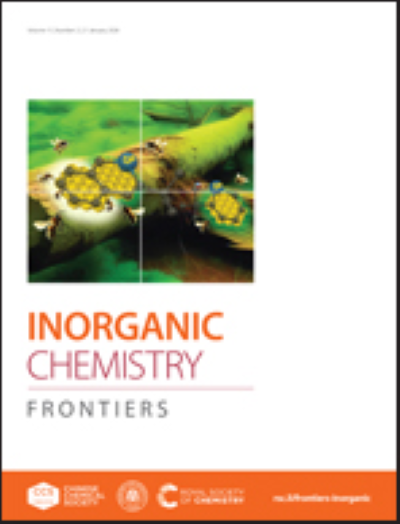Four-in-one multifunctional iron(III) complex for cancer theranostics: unique integration of targeted delivery, photodynamic therapy, and dual imaging modalities
IF 6.1
1区 化学
Q1 CHEMISTRY, INORGANIC & NUCLEAR
引用次数: 0
Abstract
3d transition metal complexes are increasingly valued for their theranostic roles in cancer, owing to their biocompatibility, cost-effectiveness, and multifunctional capabilities. We report a glucose-conjugated Fe(III) complex, Fe2, designed as a cancer theranostic agent by uniquely integrating four distinct functionalities: glucose-driven targeting, photodynamic therapy, optical imaging, and MRI contrast enhancement. Fe2 selectively targets cervical and breast cancer cells by capitalizing on the overexpression of glucose transporter-1 (GLUT-1) transmembrane protein. Its distinct ligand-to-metal charge transfer (LMCT) absorption band in the red region enables effective red-light photodynamic therapy for deep-tissue penetration, while its emission band supports optical cellular imaging. Additionally, its high-spin paramagnetic Fe(III) center facilitates T1-weighted MRI contrast enhancement. Fe2 demonstrates good water solubility and high aqueous stability under dark and irradiated conditions and in reducing environments, such as in the presence of reduced glutathione (GSH). Fe2 shows significant red-light phototoxicity in cervical (HeLa) and breast (MCF-7) cancer cells (IC50 ~ 14.1 and 9.2 µM, respectively) while being non-toxic in the dark or healthy breast epithelial cells (MCF-10A, IC50 > 200 µM). Cytotoxicity and cellular uptake studies confirm GLUT-1-mediated selective uptake of Fe2 in cancer cells over normal cells. Fe2 induces apoptosis via oxidative stress, activating both type-I and type-II photophysical pathways upon irradiation. Optical imaging studies confirm Fe2’s mitochondrial localization in HeLa and MCF-7 cells. Fe2 exhibits impressive relaxivity (r1p = 5.2 mM–1 s–1), attributed to interactions with human serum, and MRI phantom studies confirm significant contrast enhancement in MCF-7 cells. To our knowledge, Fe2 is the first complex to uniquely integrate these four functionalities, establishing it as a promising theranostic candidate and paving the way for designing carbohydrate-conjugated, photoactive paramagnetic complexes for targeted cancer theranostics.四合一多功能铁(III)复合物用于癌症治疗:靶向递送、光动力治疗和双重成像模式的独特整合
3d过渡金属配合物由于其生物相容性、成本效益和多功能能力,在癌症治疗中的作用越来越受到重视。我们报道了一种葡萄糖偶联铁(III)复合物Fe2,它被设计为一种癌症治疗剂,它独特地整合了四种不同的功能:葡萄糖驱动靶向、光动力治疗、光学成像和MRI对比增强。Fe2通过利用葡萄糖转运蛋白-1 (GLUT-1)跨膜蛋白的过度表达选择性靶向宫颈癌和乳腺癌细胞。其独特的配体到金属电荷转移(LMCT)吸收带在红色区域,使有效的红光光动力治疗深层组织渗透,而其发射带支持光学细胞成像。此外,其高自旋顺磁性Fe(III)中心有助于t1加权MRI对比增强。Fe2在黑暗和辐照条件下以及在还原性环境(如还原性谷胱甘肽(GSH))存在下表现出良好的水溶性和高水稳定性。Fe2对宫颈癌(HeLa)和乳腺癌(MCF-7)癌细胞表现出明显的红光光毒性(IC50 ~ 14.1和9.2µM),而对深色或健康乳腺上皮细胞(MCF-10A, IC50 >;200µM)。细胞毒性和细胞摄取研究证实了glut -1介导的肿瘤细胞对Fe2的选择性摄取高于正常细胞。Fe2通过氧化应激诱导细胞凋亡,激活i型和ii型光物理途径。光学成像研究证实了Fe2在HeLa和MCF-7细胞中的线粒体定位。Fe2表现出令人印象深刻的弛豫性(r1p = 5.2 mM-1 s-1),归因于与人血清的相互作用,MRI幻象研究证实MCF-7细胞的对比度显着增强。据我们所知,Fe2是第一个独特整合这四种功能的配合物,确立了它作为一种有前途的治疗候选者,并为设计用于靶向癌症治疗的碳水化合物缀合、光活性顺磁配合物铺平了道路。
本文章由计算机程序翻译,如有差异,请以英文原文为准。
求助全文
约1分钟内获得全文
求助全文
来源期刊

Inorganic Chemistry Frontiers
CHEMISTRY, INORGANIC & NUCLEAR-
CiteScore
10.40
自引率
7.10%
发文量
587
审稿时长
1.2 months
期刊介绍:
The international, high quality journal for interdisciplinary research between inorganic chemistry and related subjects
 求助内容:
求助内容: 应助结果提醒方式:
应助结果提醒方式:


